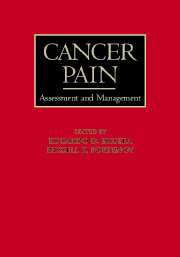Book contents
- Frontmatter
- Contents
- List of contributors
- Preface
- SECTION I MECHANISMS AND EPIDEMIOLOGY
- SECTION II ASSESSMENT AND SYNDROMES
- SECTION III PHARMACOLOGICAL TREATMENT
- SECTION IV NONPHARMACOLOGICAL APPROACHES
- SECTION V THE ROLE OF ANTINEOPLASTIC THERAPIES IN PAIN CONTROL
- SECTION VI PAIN IN SPECIAL POPULATIONS
- SECTION VII DIFFICULT PAIN PROBLEMS
- 21 Cancer pain and depression
- 22 Neuropathic pain
- 23 Breakthrough pain
- 24 Bone pain
- SECTION VIII SPECIAL TOPICS
- Index
23 - Breakthrough pain
from SECTION VII - DIFFICULT PAIN PROBLEMS
Published online by Cambridge University Press: 08 October 2009
- Frontmatter
- Contents
- List of contributors
- Preface
- SECTION I MECHANISMS AND EPIDEMIOLOGY
- SECTION II ASSESSMENT AND SYNDROMES
- SECTION III PHARMACOLOGICAL TREATMENT
- SECTION IV NONPHARMACOLOGICAL APPROACHES
- SECTION V THE ROLE OF ANTINEOPLASTIC THERAPIES IN PAIN CONTROL
- SECTION VI PAIN IN SPECIAL POPULATIONS
- SECTION VII DIFFICULT PAIN PROBLEMS
- 21 Cancer pain and depression
- 22 Neuropathic pain
- 23 Breakthrough pain
- 24 Bone pain
- SECTION VIII SPECIAL TOPICS
- Index
Summary
Introduction
During the 1970s and 1980s, when it became increasingly clear that intense pain had long been an underrecognized and poorly treated manifestation of cancer, it became apparent that cancer patients commonly experience intermittent exacerbations of severe pain against a background of continuous, or baseline, pain (1,2). On the heels of the World Health Organization analgesic ladder approach to general pain control, this recognition led to treatment guidelines and patient care manuals recommending management of these episodic pains as routine practice (3–9).
The term breakthrough pain (BTP) can be found in the pain management literature starting about a decade ago (10–14). An operational definition was offered at that time by Portenoy and Hagen (15), who suggested that “breakthrough pain … refers generally to a transitory exacerbation of pain that occurs on a background of otherwise stable pain in a patient receiving chronic opioid therapy.” This definition seems to have gained wide-spread acceptance, with only minimal (published) debate as to its overall accuracy or utility (16).
Evidence that BTP, at the very least, has become recognized as an important aspect of overall cancer care can be found on two fronts. First, a growing number of review articles and practice recommendation guidelines on this subject have been published in recent years. They affirm the view that BTP needs to be evaluated and treated as part of the overall cancer pain management plan (17–29). In addition, reports of analgesic clinical trials for the management of cancer pain have begun to routinely incorporate a treatment arm for BTP in the methodology (30–37).
- Type
- Chapter
- Information
- Cancer PainAssessment and Management, pp. 408 - 412Publisher: Cambridge University PressPrint publication year: 2003



